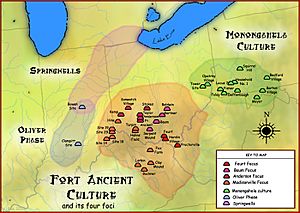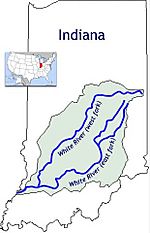Oliver Phase facts for kids
The Oliver Phase was a group of Native American people who lived a long time ago. They were part of the Late Woodland period, from about 1200 to 1450 CE. These people lived in central and southern Indiana, near the east and west branches of the White River.
The Oliver Phase was part of a larger group called the Western Basin Tradition. This tradition also included other groups like the Springwells Phase and the Younge Phase. The Oliver people lived in villages and were mostly farmers. They grew a lot of maize (corn). They were similar to other Late Woodland groups in the area, such as the Oneota, Fort Ancient, and Monongahela cultures. An archaeologist named James B. Griffin first used the name "Oliver Phase" in 1946. He used it to describe a type of pottery found mainly in Hamilton and Marion counties. This pottery was first studied a lot at a place called the Bowen site.
Archaeological Discoveries
Archaeologists study old things to learn about people from the past. They have found many clues about the Oliver Phase.
Oliver Villages
The Oliver people built their villages in a circular shape. Like their neighbors, the Fort Ancient people, they often built wooden palisades (strong fences) around their villages. Sometimes, they also had ditches or moats. Besides large villages, they lived in smaller farmsteads.
Over time, the Oliver people moved from central Indiana more to the southeast. The Clampitt Site (12-Lr-329) is an example of one of their settlements. It was studied in 1992. This site was a farming village from a very old time. Most settlements in this area were either big villages or small hunting camps.
Larger villages like Clampitt (in Lawrence County) and the Bowen site (in Marion County) were about one to two acres big. The Oliver people chose to build their villages on flat, rich land near rivers. This land, called floodplains, was good for farming. They usually built their villages about a kilometer away from smaller streams that flowed into the main river. The Bowen Site (12 MA 61) was located near the West Fork of the White River, close to Indianapolis. Different groups of people lived there at least two times.
Oliver Pottery
Archaeologists first figured out that the Oliver Phase existed by studying their pottery. Most of their pottery items were round, jar-shaped pots. They used crushed rock, called grit, to strengthen the clay. Their pottery showed a mix of styles. These styles were similar to those of the Great Lakes Late Woodland Oneota and Fort Ancient cultures.



